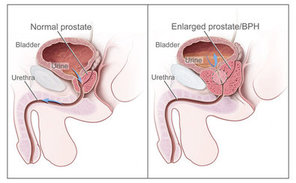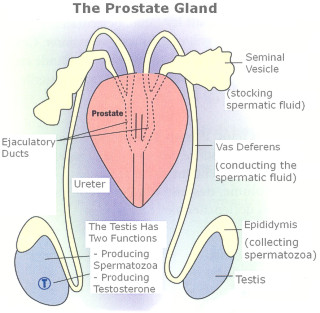
Prostate is a Greek word which means ‘one who stands before’ and hence surrounds or protects the top part of the urethra and is located just below the bladder. The only exocrine organ, which is located in the midline, it is found only in male human bodies. It is because of the secretions from the Prostate that the urethra remains moist and nourishes the sperm.
The Prostate is a small, muscular and walnut-sized male reproductive gland that is located between the root of the penis and the anus, below the bladder in the pelvic body cavity. It is the only exocrine part in the male body which produces the fluid that carries the sperm during ejaculation. As it surrounds the urethra, it moves out from the bladder to merge with the ducts at the ejaculatory duct.

Prostate cancer develops in the Prostate gland and spreads to the other parts of the body, particularly the bones and the lymph nodes. The Prostate is enlarged in size when an individual suffers from Prostate cancer. It spreads slowly and hence, males above the age of 50 years suffer from it. The disease is hereditary and hence can be contracted by any male member in the family. The disease is usually associated with the urinary dysfunction, it is the Prostate gland that surrounds the urethra and therefore, it directly affects the urinary function. The common symptoms include increased urination in the night, difficulty in starting the stream of urine, blood in the urine, pain during urination, and pain in the bones, pelvis or ribs. Also, due to the deposits of the seminal fluid in the prostatic urethra and the secretions of the Prostate gland in the semen, there may be problems in the sexual function such as difficulty in the erection or painful ejaculation.

The structure of the Prostate is very distinct. It can be divided into two ways, namely, by lobe and by zone.
-
Zone: The structure of zone is a common one and is used in pathology very often. There are four distinct glandular regions that relate with the zone classification of the Prostate.
-
Peripheral Zone (PZ): It surrounds the distal urethra and is the sub-capsular portion of the posterior aspect of the Prostate gland. It is more so because of this gland that the prostatic cancers originate.
-
Central Zone (CZ): The ejaculatory ducts are surrounded by the Central Zone and roughly accounts to about 2.5 percent of prostatic cancer. These are more aggressive and invade the seminal vesicles.
-
Transition Zone (TZ): The disease of benign prostatic enlargement is caused because of the Transition Zone. It is the Transition Zone that enables the Prostate gland to grow throughout and surrounds the proximal urethra.
-
Anterior fibro-muscular Zone: It is also called the stroma. As the name suggests, it is muscular, fibrous tissue and is devoid of the glandular components.
-
Lobe: Often used in anatomy,
lobe can be further classified into:
-
Anterior Lobe: A part of the Transitional Zone is roughly corresponded by the Anterior Lobe
-
Posterior Lobe: It roughly corresponds to the peripheral zone
-
Lateral Lobe: The lateral Zone covers and spans all the zones
-
Median Lobe: Also called the middle lobe, it corresponds to the Central Zone

The primary function of the Prostate gland is to secrete an alkaline fluid, which carries sperm. The muscular glands propel the fluid along with the sperm produced in the testicles into the urethra during the male orgasm. During ejaculation the semen leaves the body through the tip of the penis. Most of the spermatozoa are expelled along with the prostatic fluid in the first ejaculate fractions. Also, the Prostate helps to expel semen during ejaculation as it contains some smooth muscles. A very important function of the Prostate is to make the semen alkaline. It is because of the alkalinity of the semen that helps to neutralize the acidity of the vaginal tract, which helps in the prolonged life of the sperm.

The Prostate conditions are:
-
Prostatitis: It is caused by infection or the inflammation of the Prostate and is treated with antibiotics.
-
Enlarged Prostate: It is also called benign prostatic hypertrophy (BPH). The common symptoms are difficult in urination and affects males over the age of 50 years.
-
Prostate Cancer: It is the most common cancer found in men. The general treatment is surgery, radiation, hormone therapy and chemotherapy.
G Kowledge of | 0 Comments >>
0 Comments
Leave Comment
Your email address will not be published. Required fields are marked.